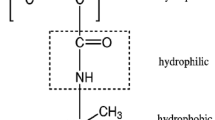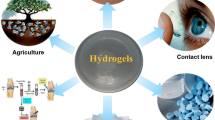Abstract
Temperature-responsive polymers have garnered significant attention due to their ability to respond to external stimuli. In this work, dual temperature-responsive block copolymers are synthesized via reversible addition-fragmentation chain transfer polymerization (RAFT) polymerization utilizing zwitterionic monomer methacryloyl ethyl sulfobetaine (SBMA) and N-isopropyl acrylamide (NIPAAm) as monomers. The thermal responsive behaviors can be easily modulated by incorporating additional hydrophobic monomer benzyl acrylate (BN) or hydrophilic monomer acrylic acid (AA), adjusting concentration or pH, or varying the degree of polymerization of the block chain segments. The cloud points of the copolymers are determined by UV-Vis spectrophotometry, and these copolymers exhibit both controlled upper and lower critical solubility temperatures (LCST and UCST) in aqueous solution. This study analyzes and summarizes the influencing factors of dual temperature responsive block copolymers by exploring the effects of various conditions on the phase transition temperature of temperature-sensitive polymers to explore the relationship between their properties and environment and structure to make them more selective in terms of temperature application range and regulation laws. It is very interesting that the introduction of poly-acrylic acid (PAA) segments in the middle of di-block copolymer PSBMA55-b-PNIPAAm80 to form PSBMA55-b-PAAx-b-PNIPAAm80 results in a reversal of temperature-responsive behaviors from ‘U’ (LCST < UCST) to ‘n’ (LCST > UCST) type, while the copolymer PSBMA55-b-P(NIPAAm80-co-AAx) not. This work provides a clue for tuning the phase transition behavior of polymers for manufacture of extreme smart materials.
Similar content being viewed by others
References
Hirayama, S.; Oohora, K.; Uchihashi, T.; Hayashi, T. Thermoresponsive micellar assembly constructed from a hexameric hemoprotein modified with poly(N-isopropylacrylamide) toward an artificial light-harvesting system. J. Am. Chem. Soc. 2020, 142, 1822–1831.
Chen, Y.; Tong, J.; Dong, J.; Luo, J.; Liu, X. A temperature-responsive boronate core cross-linked star (CCS) polymer for fast and highly efficient enrichment of glycoproteins. Small 2019, 15, 1900099.
Zhang, Z.; Collum, D. B. Structures and reactivities of sodiated evans enolates: role of solvation and mixed aggregation on the stereochemistry and mechanism of alkylations. J. Am. Chem. Soc. 2019, 141, 388–401.
Miao, Z.; Kubo, T.; Pal, D.; Sumerlin, B. S.; Veige, A. S. pH-responsive water-soluble cyclic polymer. Macromolecules 2019, 52, 6260–6265.
Zhao, Y.; Zhu, W.; Wu, Y.; Qu, L.; Liu, Z.; Zhang, K. An aggregation-induced emission star polymer with pH and metal ion responsive fluorescence. Polym. Chem. 2016, 7, 6513–6520.
Chen R.; Jiang X.; Lu G.; Liu W.; Jin W.; Tian G.; Huang X. A well-defined thermo- and pH-responsive double hydrophilic graft copolymer bearing pyridine-containing backbone. Polym. Chem. 2022, 13, 2791–2802.
Zhou, Y.; Tan, J.; Chong, D.; Wan, X.; Zhang, J. Rapid near-infrared light responsive shape memory polymer hybrids and novel chiral actuators based on photothermal W18O49 nanowires. Adv. Funct. Mater. 2019, 29, 1901202.
Pantuso, E.; Filpo, G.; Nicoletta, F. P. Light-responsive polymer membranes. Adv. Opt. Mater. 2019, 7, 1900252.
Dong, Y. Z.; Kwon, S. H.; Choi, H. J.; Puthiaraj, P.; Ahn, W. S. Electroresponsive polymer-inorganic semiconducting composite (MCTP-Fe3O4) particles and their electrorheology. ACS Omega 2018, 3, 17246–17253.
Servant, A.; Methven, L.; Williams, R. P.; Kostarelos, K. Electroresponsive polymer-carbon nanotube hydrogel hybrids for pulsatile drug delivery in vivo. Adv. Healthc. Mater. 2013, 2, 806–811.
Qiu, N.; Gao, J.; Liu, Q.; Wang, J.; Shen, Y. Enzyme-responsive charge-reversal polymer-mediated effective gene therapy for intraperitoneal tumors. Biomacromolecules 2018, 19, 2308–2319.
Wright, D. B.; Thompson, M. P.; Touve, M. A.; Carlini, A. S.; Gianneschi, N. C. Enzyme-responsive polymer nanoparticles via ring-opening metathesis polymerization-induced self-assembly. Macromol. Rapid Commun. 2019, 40, 1800467.
Hosomi, T.; Masai, H.; Fujihara, T.; Tsuji, Y.; Terao, J. A typical metal-ion-responsive color-tunable emitting insulated piconjugated polymer film. Angew. Chem. Int. Ed. 2016, 55, 13427–13431.
Huang, Y.; Moini Jazani, A.; Howell, E. P.; Oh, J. K.; Moffitt, M. G. Controlled microfluidic synthesis of biological stimuli-responsive polymer nanoparticles. ACS Appl. Mater. Interfaces 2020, 12, 177–190.
Zhang, Q. M.; Xu, W.; Serpe, M. J. Optical devices constructed from multiresponsive microgels. Angew. Chem. Int. Ed. 2014, 53, 4827–4831.
Roy, D.; Brooks, W. L. A.; Sumerlin, B. S. New directions in thermoresponsive polymers. Chem. Soc. Rev. 2013, 42, 7214–7243.
Niskanen, J.; Tenhu, H. How to manipulate the upper critical solution temperature (UCST)?. Polym. Chem. 2017, 8, 220–232.
Quiroz, F. G.; Chilkoti, A. Sequence heuristics to encode phase behaviour in intrinsically disordered protein polymers. Nat. Mater. 2015, 14, 1164–1171.
Pradnya N. P.; Ghoderao, P. N. P.; Lee, C. W.; Byun, H. S. Phase behavior for the poly(2-ethyl-2-oxazoline) supercritical DME alcohol and carbon dioxide 2-ethyl-2-oxazoline mixtures at high pressure. Chem. Eng. J. 2023, 270, 118566.
Seuring, J.; Agarwal, S. Polymers with upper critical solution temperature in aqueous solution. Macromol. Rapid Commun. 2012, 33, 1898–1920.
Southall, N. T.; Dill, K. A.; Haymet, A. D. J. A View of the hydrophobic effect. J. Phys. Chem. B 2002, 106, 521–533.
Mori, T.; Nakashima, M.; Fukuda, Y.; Minagawa, K.; Tanaka, M.; Maeda, Y. Soluble-insoluble-soluble transitions of aqueous poly(N-vinylacetamide-co-acrylic acid) solutions. Langmuir 2006, 22, 4336–4342.
Hogan, K. J.; Mikos, A. G. Biodegradable thermoresponsive polymers: applications in drug delivery and tissue engineering. Polymer 2020, 211, 123063.
Kotsuchibashi, Y.; Ebara, M.; Aoyagi, T.; Narain, R. Recent advances in dual temperature responsive block copolymers and their potential as biomedical applications. Polymers 2016, 8, 380–405.
Sun, Y.; Nan, D.; Jin, H.; Qu, X. Recent advances of injectable hydrogels for drug delivery and tissue engineering applications. Polym. Test. 2020, 81, 106283.
Tanaka, T.; Okamoto, M. Reversible temperature-responsive and lectin-recognizing glycosylated block copolymers synthesized by RAFT polymerization. Polym. J. 2018, 50, 523–531.
Marques, C. F.; Diogo, G. S.; Pina, S.; Oliveira, J. M.; Silva, T. H.; Reis, R. L. Collagen-based bioinks for hard tissue engineering applications: a comprehensive review. J. Mater. Sci. Mater. Med. 2019, 30, 32–44.
Ueki, T. Stimuli-responsive polymers in ionic liquids. Polym. J. 2014, 46, 646–655.
Wang, S.; Liu, Q.; Li, L.; Urban, M. W. Recent advances in stimuli-responsive commodity polymers. Macromol. Rapid Commun. 2021, 42, 2100054.
Song, Z.; Wang, K.; Gao, C.; Wang, S.; Zhang, W. A new thermo-, pH-, and CO2-responsive homopolymer of poly[N-[2-(diethylamino)ethyl]acrylamide]: is the diethylamino group underestimated?. Macromolecules 2016, 49, 162–171.
Seuring, J.; Agarwal, S. Non-ionic homo- and copolymers with H-donor and H-acceptor units with an UCST in water. Macromol. Chem. Phys. 2010, 211, 2109–2117.
Roth, P. J.; Jochum, F. D.; Forst, F. R.; Zentel, R.; Theato, P. Influence of end groups on the stimulus-responsive behavior of poly[oligo(ethylene glycol) methacrylate] in water. Macromolecules 2010, 43, 4638–4645.
Feil, H.; Bae, Y. H.; Feijen, J.; Kim, S. W. Effect of comonomer hydrophilicity and ionization on the lower aritical solution temperature of iV-isopropylacrylamide copolymers. Macromolecules 1993, 26, 2496–2500.
Liu, H.; Ding, A.; Ma, C.; Huang, X.; Feng, C.; Wang, Z.; Wang, Z.; Lu, G. The difluoromethylthio moiety lowers the LCST of oligo(ethylene glycol)-based homopolymers. Polym. Chem. 2020, 11, 5833–5843.
Woodfield, P. A.; Zhu, Y.; Pei, Y.; Roth, P. J. Hydrophobically modified sulfobetaine copolymers with tunable aqueous UCST through postpolymerization modification of poly(pentafluorophenyl acrylate). Macromolecules 2014, 47, 750–762.
Roth, P. J.; Davis, T. P.; Lowe, A. B. Comparison between the LCST and UCST transitions of double thermoresponsive diblock copolymers: insights into the behavior of POEGMA in alcohols. Macromolecules 2012, 45, 3221–3230.
Chang, Y.; Chen, W. Y.; Yandi, W.; Shih, Y. J.; Chu, W. L.; Liu, Y. L.; Chu, C. W.; Ruaan, R. C.; Higuchi, A. Dual-thermoresponsive phase behavior of blood compatible zwitterionic copolymers containing nonionic poly(N-isopropyl acrylamide). Biomacromolecules 2009, 10, 2092–2100.
Willcock, H.; Lu, A.; Hansell, C. F.; Chapman, E.; Collins, I. R.; O’Reilly, R. K. One-pot synthesis of responsive sulfobetaine nanoparticles by RAFT polymerisation: the effect of branching on the UCST cloud point. Polym. Chem. 2014, 5, 1023–1030.
Seuring, J.; Bayer, F. M.; Huber, K.; Agarwal, S. Upper critical solution temperature of poly(N-acryloyl glycinamide) in water: a concealed property. Macromolecules 2011, 45, 374–384.
Liu, F.; Seuring, J.; Agarwal, S. Controlled radical polymerization of N-acryloylglycinamide and UCST-type phase transition of the polymers. J. Polym. Sci., Part A: Polym. Chem. 2012, 50, 4920–4928.
Seuring, J.; Agarwal, S. First example of a universal and cost-effective approach: polymers with tunable upper critical solution temperature in water and electrolyte solution. Macromolecules 2012, 45, 3910–3918.
Audureau, N.; Veith, C.; Coumes, F.; Nguyen, T. P. T.; Rieger, J.; Stoffelbach, F. RAFT-polymerized N-cyanomethylacrylamide-based (co)polymers exhibiting tunable UCST behavior in water. Macromol. Rapid Commun. 2021, 42, e2100556.
Sun, X.; Chen, T.; Huang, S.; Cai, F.; Chen, X.; Yang, Z.; Lu, Y.; Peng, H. Stimuli-sensitive assemblies of homopolymers. Langmuir 2009, 25, 11980–11983.
Ma, L.; Liu, R.; Tan, J.; Wang, D.; Jin, X.; Kang, H.; Wu, M.; Huang, Y. Self-assembly and dual-stimuli sensitivities of hydroxypropylcellulose-graft-poly(N,N-dimethyl aminoethyl methacrylate) copolymers in aqueous solution. Langmuir 2010, 26, 8697–8703.
Liu, S.; Liu, M. Synthesis and characterization of temperature- and pH-sensitive poly(N, N-diethylacrylamide-co-methacrylic acid). J. Appl. Polym. Sci. 2003, 90, 3563–3568.
Audureau, N.; Coumes, F.; Rieger, J.; Stoffelbach, F. ooly(N-cyanoethylacrylamide), a new thermoresponsive homopolymer presenting both LCST and UCST behavior in water. Polym. Chem. 2022, 13, 1075–1083.
Feng C.; Huang X. Polymer brushes: efficient synthesis and applications. Acc. Chem. Res. 2018, 51, 2314–2323.
Xu B.; Feng C.; Huang X. A versatile platform for precise synthesis of asymmetric molecular brush in one shot. Nat. Commun. 2017, 8, 333–841.
Tatiana V. P.; Alexandr V. B.; Yana A. K.; Anna A. O.; Vladimir V. V. Development of high flux ultrafiltration polyphenylsulfone membranes applying the systems with upper and lower critical solution temperatures: effect of polyethylene glycol molecular weight and coagulation bath temperature. J. Membr. Sci. 2018, 565, 266–280.
Ye S.; Cheng Y.; Guo Z.; Wang X.; Wei W. A lipid toolbox of sugar alcohol fatty acid monoesters for single-component lipid nanoparticles with temperature-controlled release. Colloid Surface B 2023, 228, 113426.
Hirano, T.; Li, M.; Maeda, K.; Oshimura, M.; Ute, K. Unusually large hysteresis in temperature-responsive phase-transition behavior of aqueous solutions of isotactic copolymers comprising N-ethylacrylamide and (N-isopropylacrylamide. Polymer 2020, 198, 122530.
Moraes, R. M.; Carvalho, L. T.; Alves, G. M.; Medeiros, S. F.; Bourgeat-Lami, E.; Santos, A. M. Synthesis and self-Assembly of poly(N-Vinylcaprolactam)-b-poly(epsilon-caprolactone) block copolymers via the combination of RAFT/MADIX and ring-opening polymerizations. Polymers 2020, 12, 1252–1272.
Acknowledgments
This work was financially supported by the National Natural Science Foundation of China (No. 22271207) and the Project Funded by the Priority Academic Program Development of Jiangsu Higher Education Institutions (PAPD).
Author information
Authors and Affiliations
Corresponding authors
Ethics declarations
The authors declare no interest conflict.
Rights and permissions
About this article
Cite this article
Zou, Z., Xu, X., Zhao, HT. et al. Manipulating the Phase Transition Behavior of Dual Temperature-Responsive Block Copolymers by Adjusting Composition and Sequence. Chin J Polym Sci 42, 176–187 (2024). https://doi.org/10.1007/s10118-023-3041-0
Received:
Accepted:
Published:
Issue Date:
DOI: https://doi.org/10.1007/s10118-023-3041-0




